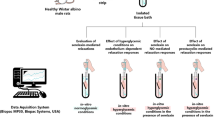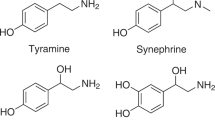Abstract
SMOOTH muscle tone seems to be primarily regulated by the concentration of free calcium in cytoplasm1,2. Several agents that cause smooth muscle contraction increase the tissue content of cyclic GMP with no significant change or only small reduction of the cyclic AMP concentration3–7. It has been suggested5–7 that cyclic GMP may be casually involved in the contractile response of smooth muscle and that this nucleotide may act as a comediator with calcium to promote contraction. Several observations, however, are not consistent with this assumption. Although increases both in tissue tonus1,2 and in the cyclic GMP level8–10 induced by hormones and neurotransmitters are generally dependent on the presence of extracellular calcium and seem to be secondary to increased influx of calcium into the cytoplasm, the correlation between these two calcium-dependent events is poor in various tissues10–16. On the basis of such observations, we have suggested that cyclic GMP may act as a negative feedback inhibitor of hormonally stimulated calcium influx into cytoplasm8,10,11. We have studied the effects of various agents on cyclic nucleotide levels in the ductus deferens of the rat, and report here that many smooth muscle relaxants, including sodium nitroprusside (SNP), increase cyclic GMP levels in the ductus deferens.
This is a preview of subscription content, access via your institution
Access options
Subscribe to this journal
Receive 51 print issues and online access
$199.00 per year
only $3.90 per issue
Buy this article
- Purchase on Springer Link
- Instant access to full article PDF
Prices may be subject to local taxes which are calculated during checkout
Similar content being viewed by others
References
Somlyo, A. P. & Somlyo, A. V. Pharmacol. Rev. 22, 249–353 (1970).
Hurwitz, L. & Suria, A. A. Rev. Pharmacol. 11, 303–326 (1971).
Bär, H. P. Adv. Cycl. Nucl. Res. 4, 195–237 (1974).
Schultz, G. & Hardman, J. G. in Eukaryotic Cell Function and Growth (eds Dumont, J. E., Brown, B. L. & Marshall, N. J.) 667–683 (Plenum, New York, 1976).
Lee, T.-P., Kuo, J. F. & Greengard, P. Proc. natn. Acad. Sci. U.S.A. 69, 3287–3291 (1972).
Dunham, E. W., Haddox, M. K. & Goldberg, N. D. Proc. natn. Acad. Sci. U.S.A. 71, 815–819 (1974).
Andersson, R. et al. Adv. Cycl. Nucl. Res. 5, 491–518 (1975).
Schultz, G., Hardman, J. G., Schultz, K., Baird, C. E. & Sutherland, E. W. Proc. natn. Acad. Sci. U.S.A. 70, 3889–3893 (1973).
Schultz, G. & Hardman, J. G. Adv. Cycl. Nucl. Res. 5, 339–351 (1975).
Schultz, G., Schultz, K. & Hardman, J. G. Metabolism 24, 429–437 (1975).
Schultz, G. in Asthma II Physiology Immunopharmacology and Treatment (eds Austen, K. F. & Lichtenstein, L. M.) (Academic, New York, 1977).
Diamond, J. & Hartle, D. K. Canad. J. Physiol. Pharmacol. 52, 763–767 (1974).
Diamond, J. & Holmes, T. G. Canad. J. Physiol. Pharmacol. 53, 1099–1107 (1975).
Clyman, R. I., Sandler, J. A., Manganiello, V. & Vaughan, M. J. clin. Invest. 55, 1020–1025 (1975).
Diamond, J. & Hartle, D. K. J. Cycl. Nucl. Res. 2, 179–188 (1976).
Diamond, J. & Blisard, K. S. Molec. Pharmacol. 12, 688–692 (1976).
Kreye, V. A. W., Baron, G. D., Lüth, J. B. & Schmidt-Gayk, H. Naunyn-Schmiedeberg's Arch. Pharmacol. 288, 381–402 (1975).
Hurwitz, L. & Joiner, P. D. Am. J. Physiol. 218, 12–19 (1970).
Schultz, G., Hardman, J. G., Schultz, K., Davis, J. W. & Sutherland, E. W. Proc. natn. Acad. Sci. U.S.A. 70, 1721–1725 (1973).
Kimura, H., Mittal, C. K. & Murad, F. Nature 257, 700–702 (1975).
Katsuki, S. & Murad, F. Pharmacologist 18, 220, (1976).
De Rubertis, F. R. & Craven, P. A. Science 193, 897–899 (1976).
Pöch, G. & Umfahrer, W. Naunyn-Schmiedeberg's Arch. Pharmacol. 293, 257–268 (1976).
Fleckenstein, A., Grün, G., Tritthart, H., Byon, K. & Harding, P. Klin. Wschr. 49, 32–41 (1971).
Grün, G. & Fleckenstein, A. Arzneim.-Forsch. 22, 334–344 (1972).
Godfraind, T. & Kaba, A. Arch. int. Pharmacodyn. Suppl. 196, 35–49 (1972).
Author information
Authors and Affiliations
Rights and permissions
About this article
Cite this article
SCHULTZ, KD., SCHULTZ, K. & SCHULTZ, G. Sodium nitroprusside and other smooth muscle-relaxants increase cyclic GMP levels in rat ductus deferens. Nature 265, 750–751 (1977). https://doi.org/10.1038/265750a0
Received:
Accepted:
Issue Date:
DOI: https://doi.org/10.1038/265750a0
This article is cited by
-
Reduction in extracellular Ca2+ attenuates endothelium-dependent relaxation more than nitroprusside-induced relaxation
Acta Pharmacologica Sinica (2010)
-
PDE5 inhibitors beyond erectile dysfunction
International Journal of Impotence Research (2007)
-
Pentaerythrityl tetranitrate attenuates structural changes in conduit arteries evoked by long‐term NO‐synthase inhibition
British Journal of Pharmacology (2000)
-
The role of nitric oxide in the responses of the ovine digital artery to vasoactive agents and modification of these responses by endotoxin and cytokines
British Journal of Pharmacology (2000)
Comments
By submitting a comment you agree to abide by our Terms and Community Guidelines. If you find something abusive or that does not comply with our terms or guidelines please flag it as inappropriate.



